Lowell Thomas
Lowell Jackson Thomas (April 6, 1892 – August 29, 1981) was an American writer, actor, broadcaster, and traveler, best remembered for publicising T. E. Lawrence (Lawrence of Arabia). He was also involved in promoting the Cinerama widescreen system.[1]
Lowell Thomas | |
|---|---|
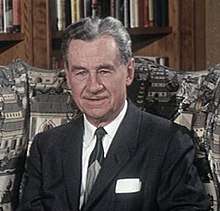 Lowell Thomas, c. 1966 | |
| Born | Lowell Jackson Thomas April 6, 1892 |
| Died | August 29, 1981 (aged 89) |
| Education | Victor High School (1910) |
| Alma mater | Valparaiso University University of Denver Princeton University |
| Occupation | Writer, broadcaster |
| Employer | Chicago-Kent College of Law |
| Spouse(s) | Frances Ryan
( m. 1917; died 1975)Marianna Munn
( m. 1977) |
| Children | Lowell Thomas Jr. |
| Parent(s) | Harry George Thomas Harriet Wagoner |
Early life
Thomas was born in Woodington, Darke County, Ohio, to Harry and Harriet (née Wagoner) Thomas. His father was a doctor, his mother a teacher. In 1900, the family moved to the mining town of Victor, Colorado. Thomas worked there as a gold miner, a cook, and a reporter on the newspaper.
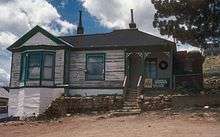
In 1911, Thomas graduated from Victor High School where one of his teachers was Mabel Barbee Lee.[2] The following year, he graduated from Valparaiso University with bachelor's degrees in education and science. The next year, he received both a B.A. and an M.A. from the University of Denver and began work for the Chicago Journal, writing for it until 1914. Thomas also was on the faculty of Chicago-Kent College of Law (now part of Illinois Institute of Technology), where he taught oratory from 1912 to 1914. He then went to New Jersey where he studied for a master's at Princeton University (he received the degree in 1916) and again taught oratory at the university.
Career
Thomas was a relentless self-promoter, and he persuaded railroads to give him free passage in exchange for articles extolling rail travel. When he visited Alaska, he hit upon the idea of the travelogue, movies about faraway places. When the United States entered World War I, President Wilson sent him and others to "compile a history of the conflict", but the mission was not academic. The war was not popular in the United States, and Thomas was sent to find material that would encourage the American people to support it. He did not want to merely write about the war, he wanted to film it.
Lawrence of Arabia
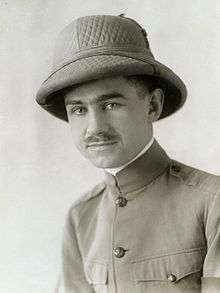
Thomas and cameraman Harry Chase first went to the Western Front, but the trenches had little to inspire the American public. They then went to Italy where he heard of General Allenby's campaign against the Ottoman Empire in Palestine. Thomas traveled to Palestine as an accredited war correspondent with the permission of the British Foreign Office, where he met T. E. Lawrence, a captain in the British Army stationed in Jerusalem. Lawrence was spending £200,000 a month encouraging the inhabitants of Palestine to rebel against the Turks. Thomas and Chase spent several weeks with him in the desert, although Lawrence had told them that it would be "several days." Lawrence agreed to provide Thomas with material on the condition that Thomas also photographed and interviewed Arab leaders such as Emir Feisal.
Thomas shot dramatic footage of Lawrence, then returned to America and began giving public lectures in 1919 on the war in Palestine, "supported by moving pictures of veiled women, Arabs in their picturesque robes, camels and dashing Bedouin cavalry". His lectures were very popular and audiences were large, and he "took the nation by storm" in the words of one modern biographer. He agreed to take the lecture to England, but only "if asked by the King and given Drury Lane or Covent Garden" as a lecture venue. His conditions were met, and he opened a series at Covent Garden on August 14, 1919. "And so followed a series of some hundreds of lecture–film shows, attended by the highest in the land".[3] At the opening of his six-month London run, there were incense braziers, exotically dressed women dancing before images of the Pyramids, and the band of the Welsh Guards playing to provide the accompaniment. Lawrence saw the show several times; he later claimed to dislike it, but it generated valuable publicity for his own book. To strengthen the emphasis on Lawrence in the show, Thomas needed more photographs of him than Chase had taken in 1918. Lawrence claimed to be shy of publicity, but he agreed to a series of posed portraits in Arab dress in London.
Thomas genuinely admired Lawrence and continued to defend him against attacks on his reputation.[4] Lawrence's brother Arnold allowed Thomas to contribute to T.E. Lawrence by his Friends (1937), a collection of essays and reminiscences published after Lawrence's death.[5]
.jpg)
Cinerama
Thomas was a magazine editor during the 1920s, but he never lost his fascination with the movies. He narrated Twentieth Century Fox's Movietone newsreels until 1952, when he went into business with Mike Todd and Merian C. Cooper to exploit Cinerama, a movie format that used three projectors and an enormous curved screen with seven-channel surround sound. He produced the documentaries This is Cinerama, Seven Wonders of the World, and Search for Paradise in this format in 1956, with a 1957 release date.[6]
Radio Commentator and Newscaster
Thomas was first heard on radio delivering talks about his travels in 1929 and 1930: for example, he spoke on the NBC Radio Network in late July 1930 about his trip to Cuba. [7] Then, in late September 1930, he took over as the host of the Sunday evening Literary Digest program, replacing the previous host, Floyd Gibbons. [8] On this program, he told stories of his travels. The show was fifteen-minutes long, and heard on the NBC Network. [9] Thomas soon changed the focus of the program from his own travels to interesting stories about other people, and by early October 1930, he was also including more news stories. It was that point that the program, which was now on six days a week, moved to the CBS Radio network. [10] After two years, he switched back to the NBC Radio network but returned to CBS in 1947. He was not an employee of either NBC or CBS, contrary to today's practices, but was employed by the broadcast's sponsor Sunoco. He returned to CBS to take advantage of lower capital-gains tax rates, establishing an independent company to produce the broadcast which he sold to CBS. He hosted the first television news broadcast in 1939 and the first regularly scheduled television news broadcast beginning on February 21, 1940 over W2XBS (now WNBC) New York, which was a camera simulcast of his radio broadcast.[11]

In the summer of 1940, Thomas anchored a television broadcast of the 1940 Republican National Convention, the first live telecast of a political convention, which was fed from Philadelphia to W2XBS and on to W2XB. He was not actually in Philadelphia but was anchoring the broadcast from a New York studio and merely identifying speakers who addressed the convention.
In April 1945, Thomas flew in a normally single-person P-51 Mustang over Berlin while it was being attacked by the Soviet Union, reporting live via radio.[12]
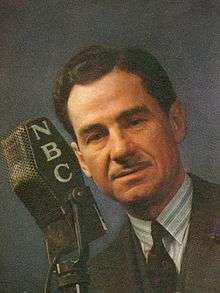
The television news simulcast was a short-lived venture for Thomas, as he favored radio. It was over radio that he presented and commented upon the news for four decades until his retirement in 1976, the longest radio career of anyone in his day, since surpassed by Paul Harvey. His signature sign-on was "Good evening, everybody" and his sign-off was "So long, until tomorrow," phrases that he used as titles for his two volumes of memoirs.
Personal life
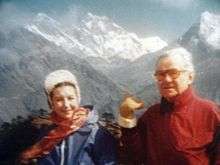
Thomas' wife Frances often traveled with him. She died in 1975, and he married Marianna Munn in 1977. They embarked on a 50,000-mile (80,000 km) honeymoon trip that took him to many of his favorite old destinations. She died in Dayton, Ohio on January 28, 2010 after suffering renal failure.[13] Thomas died at his home in Pawling, New York in 1981.[1] He is buried in Christ Church Cemetery.[14][15]
Legacy and honors
The communications building at Marist College in Poughkeepsie, New York is named in honor of Thomas, after he received an honorary degree from the college in 1981. The Lowell Thomas Archives are housed as part of the college library.[16] In 1945, Thomas received the Alfred I. duPont Award.[17] In 1971, Thomas received the Golden Plate Award of the American Academy of Achievement.[18] In 1976, President Gerald Ford awarded him the Presidential Medal of Freedom.[19] He has two stars on the Hollywood Walk of Fame and was inducted into the National Radio Hall of Fame in 1989.[20]
Published works
Among Thomas's books are:
- With Lawrence in Arabia, 1924
- The First World Flight, 1925
- Beyond Khyber Pass, 1925
- Count Luckner, The Sea Devil, 1927
- European Skyways, 1927
- The Boy's Life of Colonel Lawrence, 1927
- Adventures in Afghanistan for Boys, 1928
- Raiders of the Deep, 1928
- The Sea Devil's Fo'c'sle, 1929
- Woodfill of the Regulars, 1929
- The Hero of Vincennes: the Story of George Rogers Clark, 1929
- The Wreck of the Dumaru, 1930
- Lauterbach of the China Sea, 1930
- India--Land of the Black Pagoda, 1930
- Rolling Stone: The Life and Adventures of Arthur Radclyffe Dugmore., 1931 See Arthur Radclyffe Dugmore
- Tall Stories, 1931
- Kabluk of the Eskimo, 1932
- This Side of Hell, 1932
- Old Gimlet Eye: The Adventures of General Smedley Butler, 1933
- Born to Raise Hell, 1933
- The Untold Story of Exploration, 1935
- Fan Mail, 1935
- A Trip to New York With Bobby and Betty, 1936
- Men of Danger, 1936
- Kipling Stories and a Life of Kipling, 1936
- Seeing Canada With Lowell Thomas, 1936
- Seeing India With Lowell Thomas, 1936
- Seeing Japan With Lowell Thomas, 1937
- Seeing Mexico With Lowell Thomas, 1937
- Adventures Among the Immortals, 1937
- Hungry Waters, 1937
- Wings Over Asia, 1937
- Magic Dials, 1939
- In New Brunswick We'll Find It, 1939
- Soft Ball! So What?, 1940
- How To Keep Mentally Fit, 1940
- Stand Fast for Freedom, 1940
- Pageant of Adventure, 1940
- Pageant of Life, 1941
- Pageant of Romance, 1943
- These Men Shall Never Die, 1943
- Out of this World: Across the Himalayas to Tibet (1951)
- Back to Mandalay, 1951
- Great True Adventures, 1955
- The Story of the New York Thruway, 1955
- Seven Wonders of the World, 1956
- History As You Heard It 1957
- The Story of the St. Lawrence Seaway, 1957
- The Vital Spark, 1959
- Sir Hubert Wilkins, A Biography, 1961
- More Great True Adventures, 1963
- Book of the High Mountains, 1964 (ISBN 978-0671202392)
- Famous First Flights That Changed History, 1968 (ISBN 1-59228-536-8)
- Burma Jack, 1971 (ISBN 0-393-08647-X)
- Doolittle: A Biography, 1976 (ISBN 0-385-06495-0)
- Good Evening Everybody: From Cripple Creek to Samarkand, 1976 (ISBN 0-688-03068-8)
- So Long Until Tomorrow, 1977 (ISBN 0-688-03236-2)
Further reading
- Stephens, Mitchell (2017-06-20). The Voice of America: Lowell Thomas and the Invention of 20th-Century Journalism. New York: St. Martin's Press. ISBN 9781137279828. OCLC 957022025.
References
- Notes
- "LOWELL THOMAS, A WORLD TRAVELER AND BROADCASTER FOR 45 YEARS, DEAD". The New York Times. August 30, 1981. Retrieved 17 March 2018.
- Lee, Mabel Barbee: "Cripple Creek Days", pg. 265. Doubleday & Company, 1958 (LOC=58-12050)
- Hall, Rex (1975) The Desert Hath Pearls, (Melbourne: Hawthorn Press) pp. 120–1
- Clio Visualizing History Page, Lowell Thomas and Lawrence of Arabia."A Legacy of Ripples." Accessed 13 August 2012.
- Lawrence, A.W. (editor). T.E. Lawrence by His Friends (Doubleday: New York, 1937), pp. 163-174
- Crestview, Florida, "Cinerama Crews Shooting New Movie At Eglin AFB", The Okaloosa News-Journal – Edgewater Area News section, Thursday 1 November 1956, Volume 42, Number 44, page 1.
- "Radio Notes." Canton (OH) Sunday Repository, July 27, 1930, p. 7.
- "Gibbons Series Ends." Knoxville (TN) News-Sentinel, September 28, 1930, p. C-5.
- "Through the Static." New Britain (CT) Herald, September 29, 1930, p. 18.
- Yank Taylor. "Radio Review." Chicago Daily Times, October 4, 1930, p. 9
- http://eyesofageneration.com/wp-content/uploads/2017/02/february-21-1940-tvs-first-regularly-scheduled-news-debuts.jpg
- https://news.google.com/newspapers?id=PNlXAAAAIBAJ&sjid=cfUDAAAAIBAJ&pg=1874%2C4891161
- "Local Activist, Widow of Author and Commentator Lowell Thomas Dies at 82". Dayton Daily News. 2010. Retrieved 17 March 2018.
- Bird, David (1981-09-03). "800 HEAR PEALE PRAISE LOWELL THOMAS". The New York Times. Retrieved 2018-07-04.
Mr. Thomas will be buried in Pawling today after another service at Christ Church there.
- "William E. Sauro Dignitaries Are Among 800 Mourners at Lowell Thomas Funeral Former President Gerald R. Ford and his wife, Betty, being greeted by the Rev. Thomas D. Bowers, rector of St. Bartholomew's Episcopal Church after funeral service for Lowell Thomas. With them were Secretary of". The New York Times. September 3, 1981. Retrieved 17 March 2018.
- Carroll, Maurice; Anderson, Susan Heller (April 27, 1984). "NEW YORK DAY BY DAY; Marist College Honors Modest Walter Cronkite". The New York Times. Retrieved 17 March 2018.
- All duPont–Columbia Award Winners Archived 2012-08-14 at the Wayback Machine, Columbia Journalism School. Retrieved 2013-08-06.
- "Golden Plate Awardees of the American Academy of Achievement". www.achievement.org. American Academy of Achievement.
- "21 Named by Ford to Receive Medal of Freedom". The New York Times. 1977. Retrieved 17 March 2018.
- "Journalists Named to Hall of Fame". The New York Times. 2 May 1975. Retrieved 17 March 2018.
- Sources
- Bowen, Norman (ed) (1968) The Stranger Everyone Knows Doubleday
- Hamilton, John Maxwell (2011) Journalism's Roving Eye: A History of American Foreign Reporting LSU Press ISBN 9780807144862 pg 248
External links
| Wikimedia Commons has media related to Lowell Thomas. |
- Lowell Thomas on IMDb
- Lowell Thomas at the Internet Broadway Database
- With Lawrence in Arabia at Internet Archive
- Lowell Thomas at Find a Grave
- Lowell Thomas at the National Radio Hall of Fame
- Lowell Thomas interview at American Heritage
- "Creating History: Lowell Thomas and Lawrence of Arabia" online history exhibit at Clio Visualizing History.
- An Evening with Lowell Thomas (August 13, 1981), on the YouTube-channel of Pikes Peak Library District.
